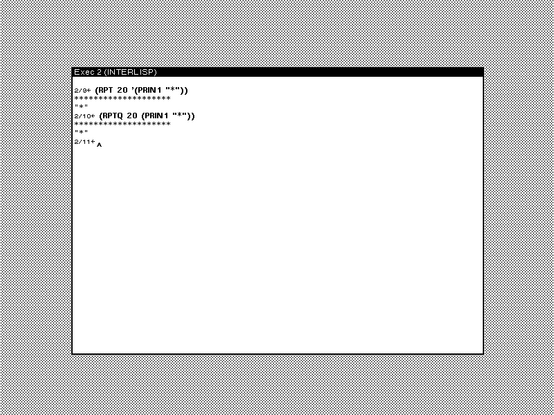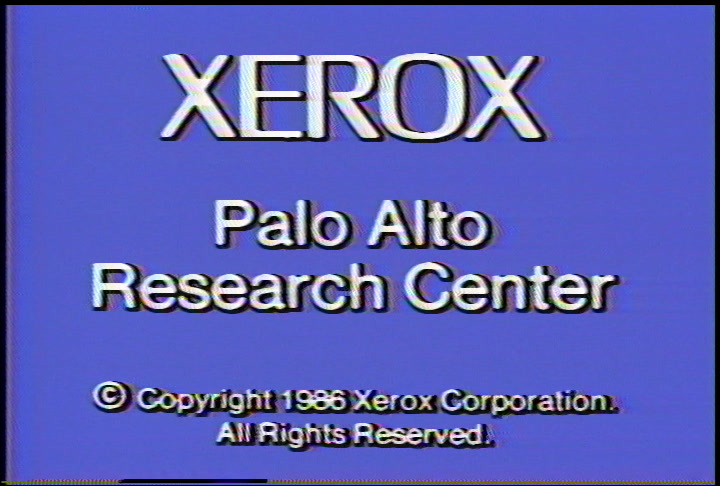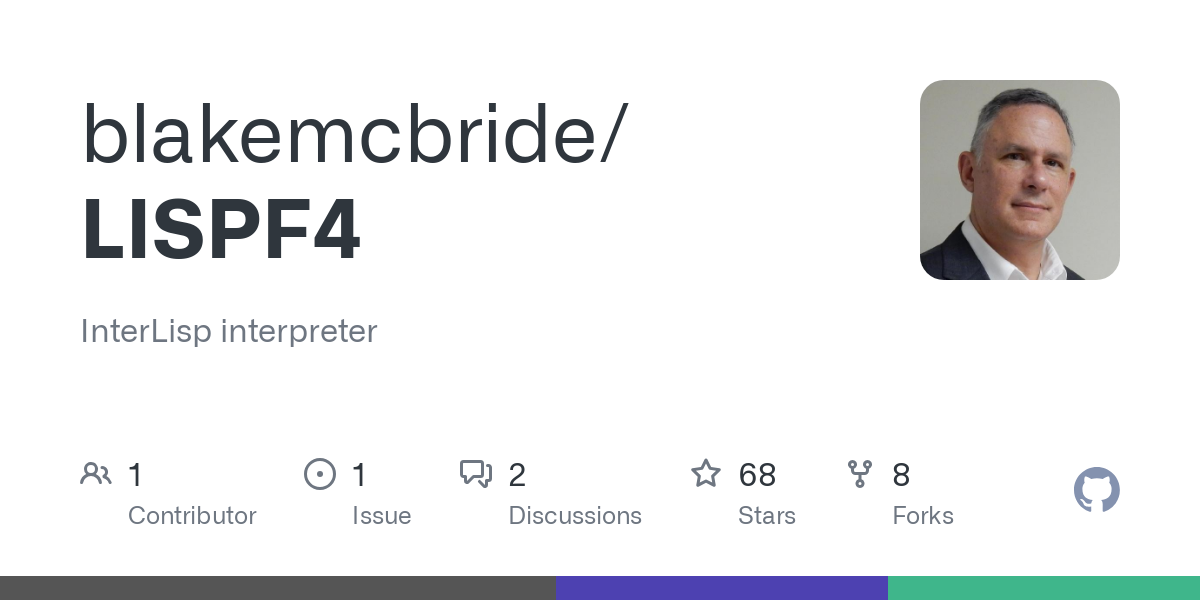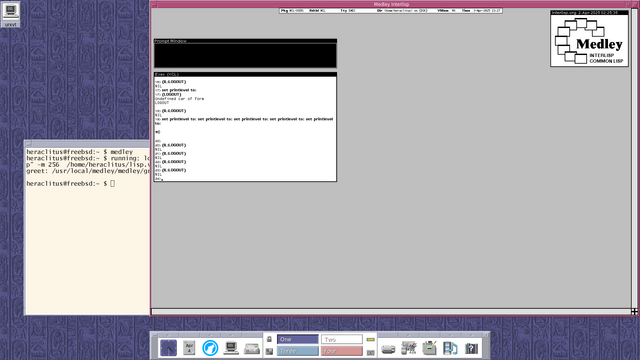RPT and RPTQ (RePeaT) are Interlisp iteration expressions that evaluate a form a specified number of times, without or with quoting. This is an example, more details in the Interlisp Reference Manual:
Recent searches
Search options
#Interlisp
I wrote two new functions of DandeGUI, my GUI library for text and graphics output on Medley Interlisp. The first function clears the text of windows, the other prints status messages.
https://journal.paoloamoroso.com/adding-window-clearing-and-message-printing-to-dandegui

The manual Medley for the Sun Workstation User’s Guide came with Medley Interlisp in the early 1990s. Although it's Sun specific and part of it is only of historical value, it still provides practical information such as on the Medley file system on Unix.
"Which convoy escorts have inoperative sonar systems"
"What is the nearest ship to Naples with a doctor on board"
"Which cruisers have less than 50 per cent fuel on board"
"How many ships carrying oil are within 340 miles of Mayport?"
These are not ChatGPT prompts but valid queries for LADDER, a natural language interface in Interlisp developed half a century ago for accessing US Navy ship databases. More details:
I'm abstracting the recurring user interface patterns and boilerplate of my Medley Interlisp programs and packaging them into DandeGUI, a GUI library for simple text and graphics output.
https://journal.paoloamoroso.com/dandegui-a-gui-library-for-medley-interlisp
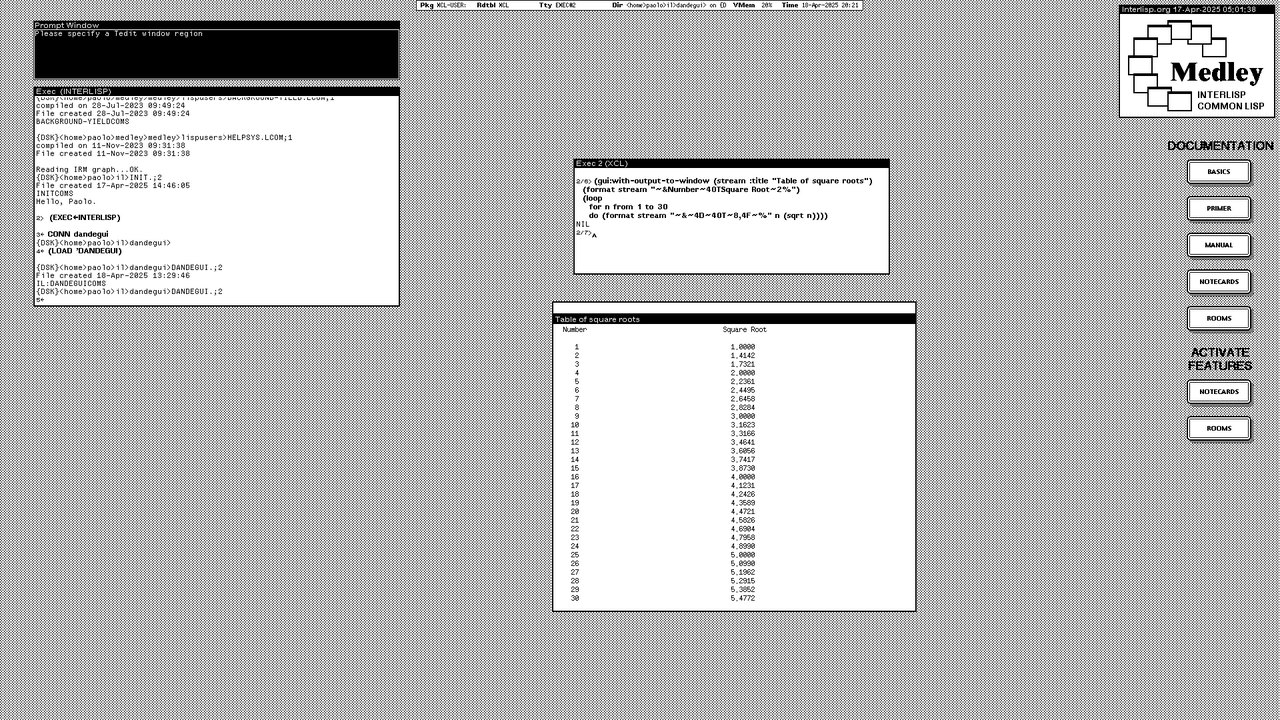
To exit a Medley Interlisp session evaluate (IL:LOGOUT) at any REPL. This also saves the state of the virtual memory to an image file.
Exit with (IL:LOGOUT T) to skip saving and the next session will start from a clean state. Or just click the window close button.
Revolutionizing GUI Development in Common Lisp: Meet DandeGUI
DandeGUI is a groundbreaking GUI library designed for Medley Interlisp, allowing developers to create rich text and graphics interfaces with ease. This innovative tool simplifies the complexities of w...
https://news.lavx.hu/article/revolutionizing-gui-development-in-common-lisp-meet-dandegui
We recommend these papers on the history of Interlisp. The first is a direct account by Warren Teitelman, one of the major driving forces behind the language. The other, by G.L. Steele and Richard Gabriel, covers Interlisp in the broader context of the evolution of Lisp.
https://interlisp.org/documentation/History_of_Interlisp.pdf
If you run Medley Interlisp on your local computer, what operating system do you use most of the time to run it? Please describe your configuration and add the relevant details in the comments.
If an error on Medley Interlisp lands you in a debugger window like this, press Ctrl-D to exit and return to the top level; type ^ and ENTER; or select ^ from the middle-click menu shown here.
Ctrl-D immediately goes to the top level from any debugger. ^ closes the most recent and switches to the previous of a series of debuggers of nested errors, or back to the top level if there are no other debuggers.
In this videotape recorded in 1986 Frank Halasz demonstrates hypertext browsers and other types of cards of NoteCards, the hypermedia system he co-developed in Interlisp at Xerox PARC.
https://archive.org/details/Notecards_Examples_Frank_Halasz_LSL
@grtcdr Here goes, Emacs in a VT100 terminal emulator on Medley Interlisp (it has a few rendering issues though).
For quite a bit more Medley screenshots see:
I created this cute little date picker dialog with the DATEFNS library of Medley Interlisp. It can optionally return the selected date as string.
DLISP, developed at Xerox PARC in the second half of the 1970s, was the first client-server window system. A window server ran on Alto workstations connected via Ethernet to Interlisp running on the MAXC PDP-10 clone.
For details on the use and design of DLISP see:
"The history feature of the UNIX C-shell introduced in the late 70’s was in fact patterned after the Interlisp history package." — Warren Teitelman
The history package is an Interlisp command history facility for Lisp expressions and command replay, undo, and editing. Teitelman introduced it in 1970 to BBN Lisp, the precursor of Interlisp.
https://interlisp.org/documentation/History_of_Interlisp.pdf#page=4
@sgharms Steven Harms published a blog post series on setting up a distraction free laptop environment based on FreeBSD, with well thought out motivations and detailed steps. I'm glad Medley Interlisp is among the core applications he installed and works well.
The Xerox PARC alumni who contribute to the Medley Interlisp project shared the buttons they collected at computing conferences in the 1980s and 1990s such as AAAI, IJCAI, SIGGRAPH.
The buttons are awesome and span a range of languages and systems such as Interlisp, Lisp Machines, Smalltalk, Unix, Modula-2, Mesa, Pilot, and more. Be sure to go through the whole thread.
https://groups.google.com/g/lispcore/c/ylsMetI3D0I/m/CtGXmMn3AQAJ
What is the main way you access Medley Interlisp?


